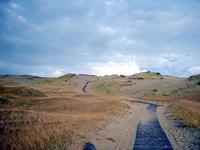You are in: Europe -> Lithuania -> Curonian Spit, and traditional search or Image Gallery will yield results of this site only
Curonian Spit
| Site number: | 994 |
|
| Type of site: | Cultural | |
| Date: | Prehistoric | |
| Date of Inscription: | 2000 | |
| Location: | Europe, Lithuania, Russian Federation, Klaipeda Region, Neringa and Klaipeda, (Lithuania) | |
Up to 75 images are shown here. Click on each for more details or on Image Gallery for more images.
Six official UN languages:
Arabic,
Chinese,
English,
French,
Russian,
Spanish
Other languages: Belarusian, Croatian, Czech, Dutch, Esperanto, Estonian, Finnish, German, Hebrew, Hungarian, Indonesian, Italian, Lithuanian, Norwegian-bokmål, Polish, Swedish, Ukrainian, Vietnamese
Other languages: Belarusian, Croatian, Czech, Dutch, Esperanto, Estonian, Finnish, German, Hebrew, Hungarian, Indonesian, Italian, Lithuanian, Norwegian-bokmål, Polish, Swedish, Ukrainian, Vietnamese
| Description: | Humans have inhabited this elongated sand dune (98 km long and 0.4-4 km wide) since prehistoric times. The natural forces of wind and waves have threatened it throughout its existence. Only through the perpetual efforts to battle the Spit’s erosion by humans have allowed it to survive to the present day; dramatic efforts have included ongoing stabilization and reforestation projects. --WHMNet paraphrase from the description at WHC Site, where additional information is available. | |
| The Curonian Spit (Lithuanian: Kuršių Nerija, Russian: Куршская коса, German: Kurische Nehrung, Latvian: Kuršu kāpas) is a 98 km long, thin, curved sand dune peninsula that separates the Curonian Lagoon from the Baltic Sea. The Curonian Spit stretches from the Sambian Peninsula on the south to its northern tip next to a narrow strait, across from which is the port city of Klaipėda on the mainland of Lithuania. The northern 52 km long stretch of the Curonian Spit peninsula belongs to Lithuania, while the rest is part of the Kaliningrad Oblast, Russia (see the map). The width of the spit varies from a minimum of 400 m in Russia (near the village of Lesnoye) to a maximum of 3,800 m in Lithuania (just north of Nida). The Curonian Spit was formed about 5,000 years ago. From ca. 800 to 1016, it was the location of Kaup, a major pagan trading centre which has not been excavated yet. The Teutonic Knights occupied the area in the 13th century, building their castles at Memel (1252), Neuhausen (1283), and at Rossitten (1372). In the 16th century, a new period of dune formation began. Deforestation of the spit due to overgrazing, timber harvesting, and building of boats for the siege of Königsberg in 1757 led to the dunes taking over the spit and burying entire villages. Alarmed by these problems, the Prussian government sponsored large-scale revegetation and reforestation efforts, which started in 1825. Owing to these efforts, much of the spit is now covered with forests. In the 19th century the Curonian Spit was inhabited primarily by Curonians (Kursenieki) with a significant German minority in the south and a Lithuanian minority in the north. The population of Curonians eventually dwindled due to assimilation and other reasons; it is close to non-existent these days and even before 1945, when the spit had become totally ethnic German. Until the 20th century, most people in the area made their living by fishing. After the breakup of the Soviet Union, tourism flourished; many Germans, mostly the descendants of the inhabitants of the area, choose the Curonian Spit (especially Nida, as no visas are needed for Germans in Lithuania) as their holiday destination. The Curonian Spit is home to the highest moving (drifting) sand dunes in Europe. Their average height is 35 m, but some attain the height of 60 m. The largest town on the spit is Nida in Lithuania, a popular holiday resort, mostly frequented by Lithuanian and German tourists. The northern shoreline of Curonian Spit is the site of beaches for tourists. Both Russian and Lithuanian parts of the spit are national parks. --Wikipedia. Text is available under the Creative Commons Attribution-ShareAlike License. | ||
| Source: | http://whc.unesco.org/en/list/994 | |
| Reference: | 1. UNESCO World Heritage Center, Site Page. | |




























